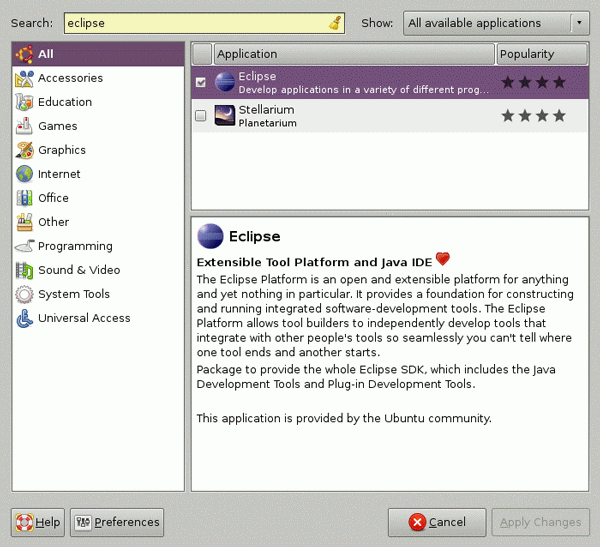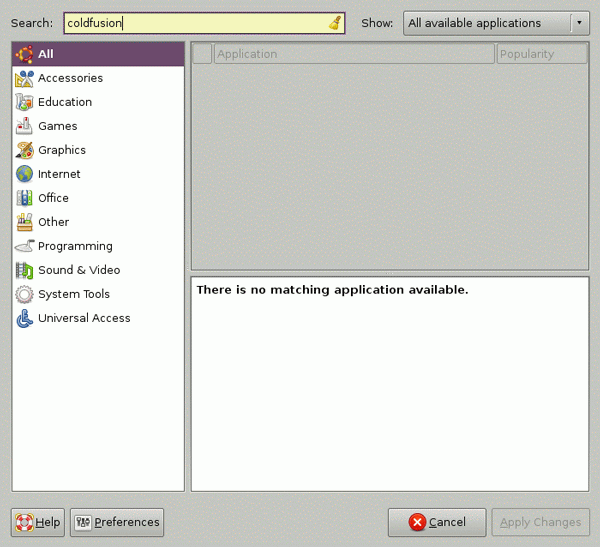Rocking ubuntu
Posted on February 19, 2008
Over the weekend, I decided to get my home development environments back in shape. I had tried installing Linux on my laptop some time ago and that was tragic. Today it’s much easier.
Installing Linux is hard
Back in 1997, I remember trying to get Red Hat Linux installed on a server at UNT. We got the basics setup, but I had no idea how to get a web server or anything else setup. Thankfully, I was given access to the school’s development (Unix) server, so I didn’t get around to really working with Linux until years later.
In 2001, I started a web hosting company with a friend and we chose Red Hat Fedora as our server platform. A few years later, we switched to CentOS. CentOS is basically an Open Source version of Red Hat Enterprise Server. It has the same packages and is community supported. In other words, it’s free.
At the end of 2002, I bought a Compaq laptop with Windows XP. It has a faster processor than my desktop and decent graphics for a mobile unit at the time. I tried to install Red Hat Fedora on the thing, but there was no graphics driver for the mobile ATI chip it has. I tried a couple of other flavors of Linux, but no luck.
I found there were websites dedicated to getting Linux installed on the model laptop I have (it was very cheap and marketed to students), but they may as well have been performing brain surgery given the instructions they had. So back to XP I went.
Installing Linux is easy
A couple of months ago, I blew away the Windows XP installation on my laptop so I could install Linux there and use the XP license on my desktop. I’d tried a Knoppix Live CD on the laptop and the graphics worked just fine, so I figured I’d take a whack at Linux as a desktop OS again.
I installed ubuntu first, as Dave Shuck and Aaron Lynch have been singing its praises. For some reason, I was having some glitches once the laptop booted. Actually, the biggest glitch was that it took over 5 minutes to boot up.
I’d heard a rumor of ubuntu 7.10 having issues with ATI graphics chips, but I couldn’t find a confirmation of that. I abandoned that for CentOS since I’d had great experiences with it as a server OS. Turns out it’s not so friendly as a desktop OS.
I found an walk-through on how to setup some of the applications I needed, but I was having problems getting video codecs installed among other things, so I let it all go for a while.
Over the weekend, I installed ubuntu 7.10 again, using the same CD as before. This time, everything worked like a charm. It only took the normal amount of time to boot up and it even prompted me to download some updates like Windows does. I told it to “install everything” and left it alone to do its thing.
Installing applications on Linux
CentOS had a package manager, but ubuntu’s seems to be more user friendly. The OS as a whole even helps you along much like Windows, but without that annoying paper clip.
When I tried to play some TV clips that I’d aquired, it prompted me that it needed to download a codec in order to play the AVI files. When it had a problem with the Divx codec, I was able to easily install VideoLAN (VLC) through ubuntu’s package manager and was watching Lost in no time at all.
Just launch the package manager, search for a program and click! you’re done. It even tells you if your system is missing some required libraries and installs them along with the selected program.
So I installed Java:

and Eclipse:

and ColdFus-d'oh!

Adobe, is there anything you could do about this?
Pleeeeeease? :)
Oh yeah, and ubuntu has a built-in screen shot application. Sure, Windows has Ctrl+PrtScn, but you still have to do a few things to get the image. This thing is just click-click! done.
Anyway
I’ve still got a list of things to install, but I don’t think it’ll take much time now. I’m looking forward to getting back in the swing of things with Linux. My current full-time job runs on Windows Server and since I sold the hosting company, I’ve been away from Linux for too long.
Adrian J. Moreno
Adrian is a CTO and solution architect specializing in software modernization. More information